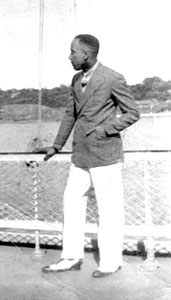|

Roscoe Conkling Wright (1900-1984),was born
in Lexington, Kentucky on September 23, 1901, to
a church-going Congregationalist family, At age
fifteen he ran away to join the Army. In World War
I he served as a Medical Corps clerk in the  Argonne
Forest, France and returned to this country fluent
in French. Wright received his education at Howard
University in Washington, D.C. and at Northeastern
University in Boston. His daughter, Mary Wright
Meekins of Virginia, relates that while in Boston
Wright lived in Roxbury) and “had the time
of his life.” He published a series of poetry,
essays, designs, and one short story in the black
literary journal Saturday Evening Quill. In the
1930s he left Boston for New York, where he secured
a job with the United States Postal Service’s
Queens branch. Argonne
Forest, France and returned to this country fluent
in French. Wright received his education at Howard
University in Washington, D.C. and at Northeastern
University in Boston. His daughter, Mary Wright
Meekins of Virginia, relates that while in Boston
Wright lived in Roxbury) and “had the time
of his life.” He published a series of poetry,
essays, designs, and one short story in the black
literary journal Saturday Evening Quill. In the
1930s he left Boston for New York, where he secured
a job with the United States Postal Service’s
Queens branch.
Wright’s daughter remembers that growin up
she saw in her home Waring Cuney, a minor Harlem
Renaissance poet whom he had met in Boston, Harlem
Renaissance novelist George Schuyler, and Gertrude
Parthenia McBrown, a little known playwright and
poet who also was part of the Boston circle of black
writers. When McBrown’s plays were performed
(mostly in local churches), Roscoe Wright was always
notified and he frequently attended.
Wright’s awareness of the Harlem scene is
evidenced by the fact that he submitted two cover
designs to the 1927 Crisis Krigwa Contest in New
York. These designs won him a second prize and an
honorable mention, respectively. Additionally, Wright
sustained a correspondence with Langston Hughes.
In 1955, Mary Meekins recalls, her father became
the second black contestant to appear on the television
show "The $64,000 Question.” This came
about as a result of his postal route clients’
encouraging him to apply. With poetry as his subject
Wright won $16,000 and went on to the "$64,000
Challenge" in 1958, winning another $8,000
in the same category. These successes made him a
hometown celebrity. However, the need to support
his growing family—including a wife, two children,
and his mother—became pressing and Wright’s
dreams of a life in literature came to naught.
Wright’s essays are striking and powerful.
In “Negro Spirituals Minus Negro Spirit”
Wright reflects on the vogue of spirituals among
both blacks and whites, proposing that one reason
for this popularity might be a desire to hark back
to the days “when the Negro was more of an
underdog than he now is.” Wright comments
slyly: “Some people like to be reminded of
those days,” but favors another reason—that
the spirituals give voice to universal emotions,
religious feeling, and rich poetry. Continuing in
this vein, Wright ventures that “[t]he modern
Negro is, at heart, not se keen on the spirituals.
But he knows that the white people like them, that
he is supposed to like them”—and performs
them.
However, Wright objects to the separation of the
songs from the milieu in which they were created.
He finds out-of-place a performance in which the
singer is dressed “in a tuxedo, or perhaps
in black cutaway coat, grey striped trousers, and
spats,” and looking “sartorially perfect
and debonair.” A female singer might be dressed
in an evening gown, carry an ostrich-plume fan and
wear fancy jewelry. Wright argues that spirituals
were meant to be group songs: “they are really
better set off by overalls, or by gingham and calico
surmounted by a bandanna.” The spirituals,
he adds, “are from and off the cotton field,
the cane patch, the rice swamp, and the ramshackle
Negro church of yesterday.” Referring perhaps
to his own Southern origins, he concludes”
“To one who has been nurtured on Negro spirituals,
the result is laughable.”
Taking on the subject of black laughter, Wright
exposes the myth of the “happy black man”
as a camouflage for unhappiness and discontent,
a “make-believe happiness.” Serious
literature, in his opinion, giving the example of
W.E.B. Du Bois’ The Dark Princess, is often
what he calls “escapist” and “romantic”.
Or, on the other hand, it manifests as a literature
of what Wright calls “protest,” as in
Claude McKay’s Home to Harlem. Throughout
the essays one senses the presence of a sharp intelligence
piercing the veil of appearances to probe underlying
realities.
Publications:
Poetry: “Four Poems” (1928)
and “Facetiae: Six Poems” (1930)
Essays: “Negro Spirituals Minus
Negro Spirit” (1928) and “Is the
Negro Happy?” (1929).
Art: Cover Design, Monogram and three
drawings (1929); Cover Design and Monogram (1930)
Short Story: “Washwoman” (1929)
Sources:
Saturday Evening Quill;
Telephone interview with Mary Wright Meekins
on February 20, 2004;
Correspondence with Mary Wright Meekins.
|


